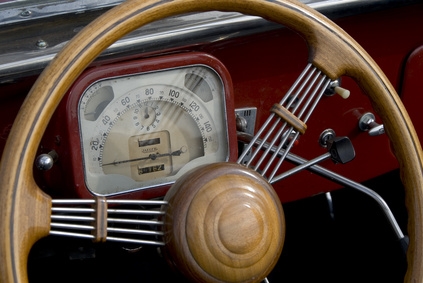
Conventional, or parallelogram, steering is different than rack and pinion steering. Rack and pinion steering does not use an idler or pitman arm. With conventional steering, the pitman arm directly connects to the steering box and transmits steering motion from the steering wheel, through the box and to the steering linkage. The idler arm anchors the opposite end of the linkage to the car frame. Both arms have lubricated ball-and-socket joints that fail over time. Periodic lubrication and inspection of these items is important, and it is crucial to replace them at the first signs of failure to help prolong tire life and ensure steering safety.
Remove the cotter pin that locks the castle nut in place where it connects the pitman arm to the center link. The center link is the longest section of the steering linkage. Remove the nut with a socket wrench, then separate the center link from the pitman arm by inserting a fork tool between the arm and the link and striking the fork firmly with a shop hammer.
Remove the large retaining nut and lock washer that holds the pitman arm onto the bottom spline of the steering box. The nut is large, and in some cases an air operated impact wrench makes the job easier than using a wrench. Slide a pitman arm puller over the shoulders of the arm and tighten the center bolt against the tapered and splined steering spindle. Continue tightening the bolt until the pitman arm releases.
Fit a new pitman arm onto the spindle. It is indexed and will only fit one way. Install the lock washer and nut and tighten it in place. Insert the threaded ball-socket extension on the pitman arm through the hole in the center link and install a new castle nut. Tighten the nut with a socket wrench and insert a new cotter pin.
Remove the idler arm by removing the cotter pin that holds the ball and socket on the arm to the opposite end of the center link. Remove the castle nut with a socket wrench and insert the fork tool between the arm and the link. Strike the tool firmly with a shop hammer and separate the arm from the link.
Remove the two mounting bolts that hold the idler arm to the car's frame by using a socket wrench. In some cases the bolts will spin, so install a wrench on the retaining nuts to hold them in place while turning the ratchet. Once removed, install a new idler arm by reversing the process of removal. Be sure and install the new castle nut and cotter pin that is supplied with the new idler arm.